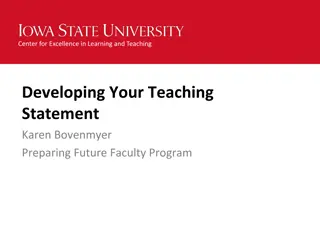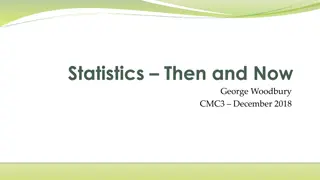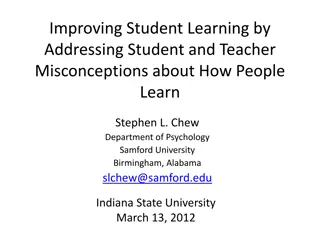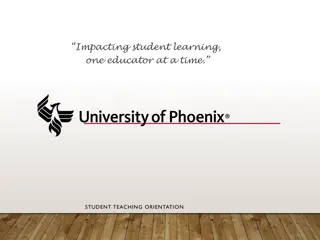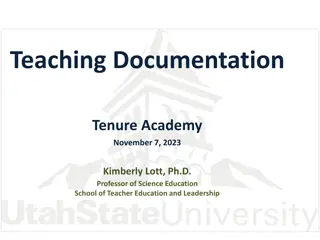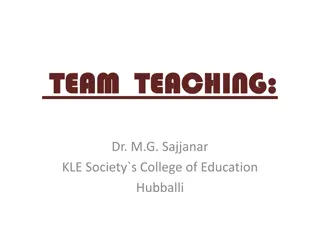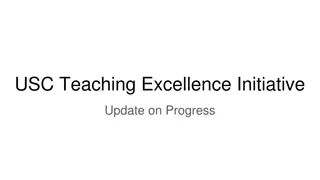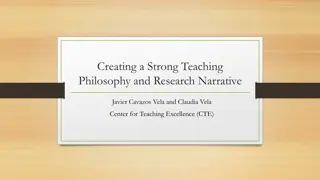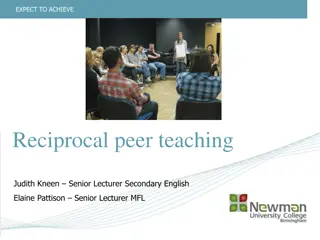Understanding the Concept and Benefits of Team Teaching in Education
Team teaching is an organizational structure that involves multiple teachers working together to enhance the learning process. By combining resources, knowledge, and skills, team teaching benefits both teachers and students through improved flexibility, collaboration, and professional development opportunities. While it offers advantages such as efficient resource use and fostering a cooperative attitude, challenges like difficulty in collaboration and shared responsibilities exist. Despite its effectiveness, team teaching is not widely implemented in Indian educational institutions.
Download Presentation

Please find below an Image/Link to download the presentation.
The content on the website is provided AS IS for your information and personal use only. It may not be sold, licensed, or shared on other websites without obtaining consent from the author. Download presentation by click this link. If you encounter any issues during the download, it is possible that the publisher has removed the file from their server.
E N D
Presentation Transcript
The meaning and Principles of Team Teaching & merits and demerits of Team Teaching During the mid 1950, the concept of Team teaching emerged in America and took 10 years to reach in England when J. Freeman (1960) gave an account of its growth in Britain. But the concept was so effective that it held a firm place in British schools and colleges. Team teaching was first introduced in Harvard University in 1955. The need of Team teaching was focused first of all by Francis Chase in University of Chicago. A successful contribution to Team teaching was made by J. Leyod Trump. In India, in spite of its effectiveness, educationists do not believe in implementing it in schools and colleges.
Meaning of Team teaching: Team teaching is an organizational structure to improve teaching learning process in the class. Team teaching is concerned with pooling of resources. Resources include factors like specialization, interests, knowledge, skills, experience of the staff of the team as well as equipment, apparatus, rooms available, periods in the time table etc. it is a combined efforts of all the members of the team to teach a group of students utilizing the expertise of the members of the team.
Characteristics of Team teaching: a) It involves two or more teachers to teach a group of students. b) Team teaching is a co-operative staff organization to plan, execute and evaluate the teaching work. c) Team teaching is an instructional strategy rather than a training strategy. d) Team teaching provides the opportunities for utilization of teacher s expertise, knowledge, skills, etc for the benefit of the students. e) It is economical from the point of view that it results in more work in less time.
Principles of Team teaching organizing Team teaching. The basic principles of Team teaching are- i) Principle of efficient use of available resources. ii) Principle of co-operation. iii) Principle of flexibility. iv) Principle of appropriate assignment of responsibilities. v) Principle of supervision.
Advantages of Team teaching; It has been devised to make best use of the expertise of the teachers. Team teaching provides more flexibility in teaching. It provides an opportunity for free discussion and interaction with the expert. Team teaching provides opportunities for full utilization of the available material resources. Team teaching helps in developing a co-operative attitude among the members of the team. Team teaching provides opportunities for professional development of the teachers. Team teaching is applicable at secondary, colleges and University level.
Disadvantages of Team teaching: i) Team teaching has no practical importance because it is very difficult to seek co-operation among different teachers. ii) Responsibilities are shared collectively in Team teaching. As a matter of fact, responsibility of all means responsibility of none. iii There is no mutual understanding, regard and respects among the teachers and that are why they do not deviate from the routine methods of teaching. iv) Mutual disregard, disagreement and these types of other attitudes of teachers hamper in progress and improvement of educational system.
Thank You Presented- Gaya Ram Basumatary Department of Education Salbari College, Salbari.





